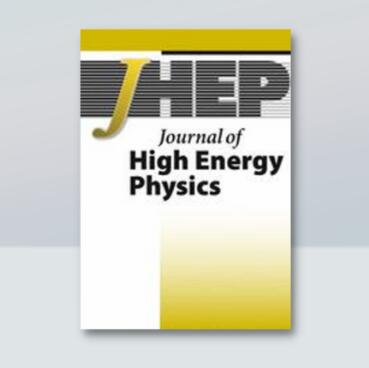二维CFT及以后的几何模流
IF 5.5
1区 物理与天体物理
Q1 Physics and Astronomy
引用次数: 0
摘要
在二维共形场理论中研究几何模流。我们探索哪些状态表现出相对于因果完备子区域的几何模流,反过来,如何从给定的几何模流构建状态。在给定合适的边界条件下,我们发现伦德勒楔中的一般几何模流是保形等价的。基于这一见解,我们将展示如何使用共形单一性来显式地为每个流构建状态。我们分析了这些状态,推导了能量密度和纠缠熵的一般公式。我们也考虑几何流动超出伦德勒楔形设置,并在更高的维度。本文章由计算机程序翻译,如有差异,请以英文原文为准。
Geometric modular flows in 2d CFT and beyond
We study geometric modular flows in two-dimensional conformal field theories. We explore which states exhibit a geometric modular flow with respect to a causally complete subregion and, conversely, how to construct a state from a given geometric modular flow. Given suitable boundary conditions, we find that generic geometric modular flows in the Rindler wedge are conformally equivalent. Based on this insight, we show how conformal unitaries can be used to explicitly construct a state for each flow. We analyze these states, deriving general formulas for the energy density and entanglement entropy. We also consider geometric flows beyond the Rindler wedge setting, and in higher dimensions.
求助全文
通过发布文献求助,成功后即可免费获取论文全文。
去求助
来源期刊

Journal of High Energy Physics
物理-物理:粒子与场物理
CiteScore
10.30
自引率
46.30%
发文量
2107
审稿时长
1.5 months
期刊介绍:
The aim of the Journal of High Energy Physics (JHEP) is to ensure fast and efficient online publication tools to the scientific community, while keeping that community in charge of every aspect of the peer-review and publication process in order to ensure the highest quality standards in the journal.
Consequently, the Advisory and Editorial Boards, composed of distinguished, active scientists in the field, jointly establish with the Scientific Director the journal''s scientific policy and ensure the scientific quality of accepted articles.
JHEP presently encompasses the following areas of theoretical and experimental physics:
Collider Physics
Underground and Large Array Physics
Quantum Field Theory
Gauge Field Theories
Symmetries
String and Brane Theory
General Relativity and Gravitation
Supersymmetry
Mathematical Methods of Physics
Mostly Solvable Models
Astroparticles
Statistical Field Theories
Mostly Weak Interactions
Mostly Strong Interactions
Quantum Field Theory (phenomenology)
Strings and Branes
Phenomenological Aspects of Supersymmetry
Mostly Strong Interactions (phenomenology).
 求助内容:
求助内容: 应助结果提醒方式:
应助结果提醒方式:


